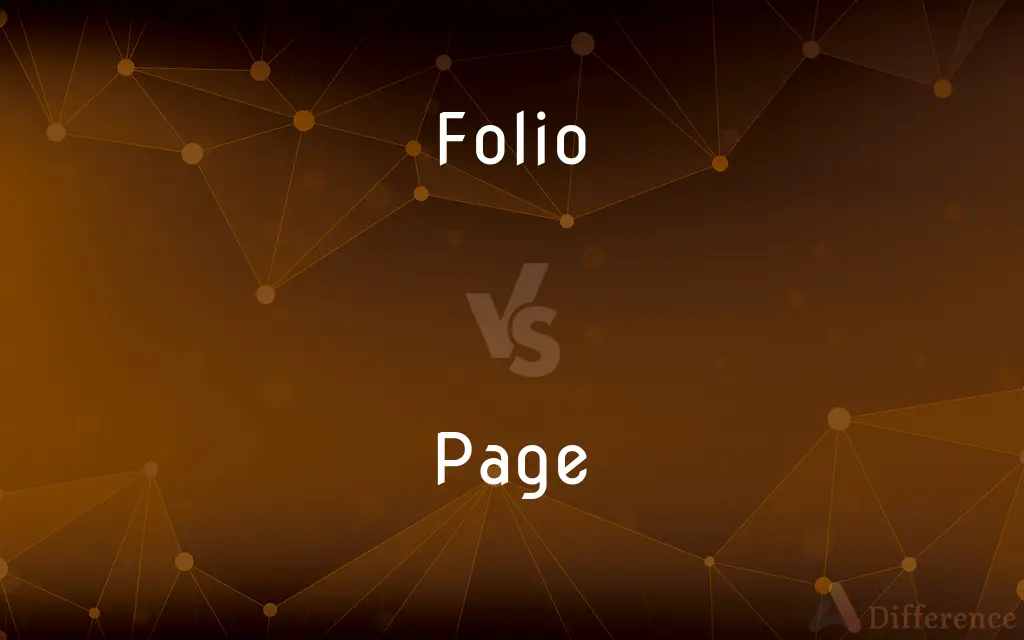Folio vs. Page — What's the Difference?
By Maham Liaqat & Urooj Arif — Updated on March 27, 2024
A folio refers to a sheet of paper folded once to form two leaves (four pages), while a page is one side of a sheet of paper in a book or publication.

Difference Between Folio and Page
Table of Contents
ADVERTISEMENT
Key Differences
A folio in publishing and book design refers to a single sheet of paper folded once, creating two leaves or four pages when printed on both sides. On the other hand, a page specifically refers to one side of a leaf in any book, magazine, or publication, representing the smallest unit of content in printed material. This distinction highlights the difference in scope between a folio, which encompasses multiple pages, and a single page.
The term "folio" also historically implies a larger book or manuscript format, where the paper is folded only once, indicating a specific size. Whereas a page can vary in size and is not dependent on the folding of paper but is defined by its position within a sequence of content, showing the versatility of pages in comparison to the more specific format of folios.
In terms of numbering, folios may be marked with numbers, letters, or other symbols on each leaf, rather than every page, to indicate their sequence in a manuscript or book. Conversely, pages are typically numbered consecutively, allowing for precise reference and navigation through the content, emphasizing the more detailed organization at the page level compared to the broader, leaf-based system of folios.
When discussing the physical aspects of books, the term "folio" highlights a method of assembly and size, reflecting traditional printing and binding techniques. A page, however, focuses on the content and its presentation, irrespective of the physical construction of the book or document, showcasing the different perspectives from which printed materials can be discussed.
Understanding the difference between folios and pages is essential for those involved in book design, publishing, and library science, as it affects how books are constructed, numbered, and referenced. While folios relate more to the physical format and assembly of books, pages are fundamental to the organization and consumption of written content.
ADVERTISEMENT
Comparison Chart
Definition
A sheet of paper folded once to form two leaves or four pages
One side of a sheet of paper in a book or publication
Unit of Measure
Considers both sides of a leaf, leading to four pages per folio
Singular side of a leaf, focusing on content presentation
Size
Implies a larger format due to the single fold
Can vary widely, not specific to folding
Numbering
Often marked per leaf, not per side
Numbered consecutively for reference
Context
Associated with traditional printing and binding methods
Central to content organization and presentation
Compare with Definitions
Folio
A sheet of paper folded once, creating two leaves or four pages.
The printer arranged the manuscript into folios for the final book assembly.
Page
One side of a leaf in any book or publication, containing text or illustrations.
The memorable quote was found on page 58 of the novel.
Folio
In libraries and archives, a reference to specific large-sized books.
The rare book collection includes several folios from the Renaissance period.
Page
The basic unit of composition in writing and publishing.
The editor requested a reduction of ten pages from the manuscript.
Folio
Historically, a large size of book or manuscript.
Medieval manuscripts were often created in folio format for durability and readability.
Page
In web design, a single, scrollable document or section of content.
The contact information is located at the bottom of the web page.
Folio
In legal and financial documents, a folio number refers to a specific record or entry.
Please reference folio number 234 for the transaction details.
Page
Used in digital documents to denote the division of content.
Scroll to page 3 of the PDF for the table of contents.
Folio
A printing term for assembling pages in a specific order during bookbinding.
The binder used the folio layout to ensure the pages were in correct order.
Page
Reference point in academic and professional citations.
As argued by the author (2010, p. 22), the theory is not without its critics.
Folio
The term "folio", from the Latin folium (leaf), has three interconnected but distinct meanings in the world of books and printing: it is firstly a term for a common method of arranging sheets of paper into book form, folding the sheet only once, and a term for a book made in this way; secondly it is a general term for a sheet, leaf or page in (especially) manuscripts and old books; and thirdly it is an approximate term for the size of a book, and for a book of this size. Firstly, a folio (abbreviated fo or 2°) is a book or pamphlet made up of one or more full sheets of paper, on each of which four pages of text are printed, two on each side; each sheet is then folded once to produce two leaves.
Page
A side of a sheet of paper, as in a book or newspaper
Tore a page from the book.
Folio
A large sheet of paper folded once in the middle, making two leaves or four pages of a book or manuscript.
Page
The writing or printing on one side of a page.
Folio
A book or manuscript of the largest common size, usually about 38 centimeters (15 inches) in height, consisting of such folded sheets.
Page
The type set for printing one side of a page.
Folio
A leaf of a book numbered only on the front side.
Page
A noteworthy or memorable event
A new page in history.
Folio
A number on such a leaf.
Page
(Computers) A webpage.
Folio
A page number.
Page
(Computers) A quantity of memory storage equal to between 512 and 4,096 bytes.
Folio
(Law) A specific number of words used as a unit for measuring the length of the text of a legal document.
Page
Pages A source or record of knowledge
In the pages of science.
Folio
To number consecutively the pages or leaves of (a book, for example).
Page
A boy who acted as a knight's attendant as the first stage of training for chivalric knighthood.
Folio
A leaf of a book or manuscript
Page
A youth in ceremonial employment or attendance at court.
Folio
A page of a book, that is, one side of a leaf of a book.
Page
One who is employed to run errands, carry messages, or act as a guide in a hotel, theater, or club.
Folio
(printing) A page number. The even folios are on the left-hand pages and the odd folios on the right-hand pages.
Page
One who is similarly employed in the US Congress or another legislature.
Folio
(paper) A sheet of paper folded in half.
Page
A boy who holds the bride's train at a wedding.
Folio
(books) A book made of sheets of paper each folded in half (two leaves or four pages to the sheet); hence, a book of the largest kind, exceeding 30 cm in height.
A rare copy of Shakespeare’s First Folio.
Page
To number the pages of; paginate
Page a manuscript.
Folio
(accounting) A page in an account book; sometimes, two opposite pages bearing the same serial number.
Page
To turn pages
Page through a magazine.
Folio
A leaf containing a certain number of words; hence, a certain number of words in a writing, as in England, in law proceedings 72, and in chancery, 90; in New York, 100 words.
Page
To summon or call (a person) by name.
Folio
A wrapper for loose papers.
Page
To contact (someone) by sending a message to that person's pager
The doctor was paged during dinner.
Folio
To put a serial number on each folio or page of (a book); to page
Page
To attend as a page.
Folio
A leaf of a book or manuscript.
Page
One of the many pieces of paper bound together within a book or similar document.
Folio
A sheet of paper once folded.
Page
One side of a paper leaf on which one has written or printed.
Folio
A book made of sheets of paper each folded once (four pages to the sheet); hence, a book of the largest kind. See Note under Paper.
Page
(figurative) Any record or writing; a collective memory.
The page of history
Folio
The page number. The even folios are on the left-hand pages and the odd folios on the right-hand.
Page
(typesetting) The type set up for printing a page.
Folio
A page of a book; (Bookkeeping) a page in an account book; sometimes, two opposite pages bearing the same serial number.
Page
(computing) A screenful of text and possibly other content; especially, the digital simulation of one side of a paper leaf.
Folio
A leaf containing a certain number of words, hence, a certain number of words in a writing, as in England, in law proceedings 72, and in chancery, 90; in New York, 100 words.
Page
(Internet) A web page.
Folio
To put a serial number on each folio or page of (a book); to page.
Page
(computing) A block of contiguous memory of a fixed length.
Folio
The system of numbering pages
Page
(obsolete) A serving boy; a youth attending a person of high degree, especially at courts, often as a position of honor and education.
Folio
A sheet of any written or printed material (especially in a manuscript or book)
Page
(British) A youth employed for doing errands, waiting on the door, and similar service in households.
Folio
A book (or manuscript) consisting of large sheets of paper folded in the middle to make two leaves or four pages;
The first folio of Shakespeare's plays
Page
A boy or girl employed to wait upon the members of a legislative body.
Page
(in libraries) The common name given to an employee whose main purpose is to replace materials that have either been checked out or otherwise moved, back to their shelves.
Page
A contrivance, as a band, pin, snap, or the like, to hold the skirt of a woman’s dress from the ground.
Page
A track along which pallets carrying newly molded bricks are conveyed to the hack.
Page
A message sent to someone's pager.
Page
Any one of several species of colorful South American moths of the genus Urania.
Page
(transitive) To mark or number the pages of, as a book or manuscript.
Page
To turn several pages of a publication.
The patient paged through magazines while he waited for the doctor.
Page
(transitive) To furnish with folios.
Page
(transitive) To attend (someone) as a page.
Page
To call or summon (someone).
Page
To contact (someone) by means of a pager or other mobile device.
I'll be out all day, so page me if you need me.
Page
(transitive) To call (somebody) using a public address system to find them.
An SUV parked me in. Could you please page its owner?
Page
A serving boy; formerly, a youth attending a person of high degree, especially at courts, as a position of honor and education; now commonly, in England, a youth employed for doing errands, waiting on the door, and similar service in households; in the United States, a boy or girl employed to wait upon the members of a legislative body. Prior to 1960 only boys served as pages in the United States Congress
He had two pages of honor - on either hand one.
Page
A boy child.
Page
A contrivance, as a band, pin, snap, or the like, to hold the skirt of a woman's dress from the ground.
Page
A track along which pallets carrying newly molded bricks are conveyed to the hack.
Page
Any one of several species of beautiful South American moths of the genus Urania.
Page
One side of a leaf of a book or manuscript.
Such was the book from whose pages she sang.
Page
A record; a writing; as, the page of history.
Page
The type set up for printing a page.
Page
To attend (one) as a page.
Page
To call out a person's name in a public place, so as to deliver a message, as in a hospital, restaurant, etc.
Page
To call a person on a pager.
Page
To mark or number the pages of, as a book or manuscript; to furnish with folios.
Page
One side of one leaf (of a book or magasine or newspaper or letter etc.) or the written or pictorial matter it contains
Page
English industrialist who pioneered in the design and manufacture of aircraft (1885-1962)
Page
United States diplomat and writer about the Old South (1853-1922)
Page
A boy who is employed to run errands
Page
A youthful attendant at official functions or ceremonies such as legislative functions and weddings
Page
In medieval times a youth acting as a knight's attendant as the first stage in training for knighthood
Page
Call out somebody's name over a P.A. system
Page
Work as a page;
He is paging in Congress this summer
Page
Number the pages of a book or manuscript
Common Curiosities
Why is page numbering important?
Page numbering is crucial for navigation, reference, and organization within a document, allowing readers and writers to locate information efficiently.
Are folios used in modern printing?
Yes, folios are still used in modern printing and bookbinding, particularly for larger books or special editions where their format is beneficial.
How is a page defined in publishing?
A page in publishing refers to one side of a leaf in a book or any printed material, serving as the primary unit for content.
What is a folio in bookmaking?
In bookmaking, a folio is a single sheet of paper folded once to create two leaves or four pages, used in the assembly of books.
Can a folio be part of a digital document?
While folio traditionally refers to physical paper, the concept can apply to the layout in digital formats, particularly in digital book design.
Can a single folio contain multiple pages?
Yes, a single folio consists of two leaves, equating to four pages when including both sides.
How do libraries categorize folios?
Libraries may categorize folios based on their size, distinguishing them from other formats for storage and reference purposes.
Why might an author or designer choose the folio format?
Authors or designers might choose the folio format for its aesthetic qualities, historical significance, or to make a physical impact with larger pages.
How do folios and pages differ in terms of size?
Folios imply a larger paper size due to the single fold, while pages can vary in size and are not specifically tied to the paper's folding.
What role do pages play in digital documents?
In digital documents, pages help organize content in a manner that mimics physical books, facilitating readability and navigation.
How has the use of folios evolved over time?
While initially indicative of size and format in manuscripts, folios now play various roles in book design, printing, and digital layouts.
How do digital and print pages compare?
Digital and print pages serve similar organizational purposes, but digital pages can be more flexible, allowing for interactive and multimedia content.
Do folios have a specific use in legal documents?
In legal and financial contexts, a folio number refers to a specific entry or record, aiding in document organization.
Is there a specific way to number folios in a manuscript?
Folios are often numbered by the leaf, not by individual pages, aiding in the organization of manuscripts and books.
What is the significance of a page in web design?
In web design, a page denotes a specific section of content within a website, crucial for structuring information online.
Share Your Discovery

Previous Comparison
Echidna vs. Pangolin
Next Comparison
Pomeranian vs. ChihuahuaAuthor Spotlight
Written by
Maham LiaqatCo-written by
Urooj ArifUrooj is a skilled content writer at Ask Difference, known for her exceptional ability to simplify complex topics into engaging and informative content. With a passion for research and a flair for clear, concise writing, she consistently delivers articles that resonate with our diverse audience.














































